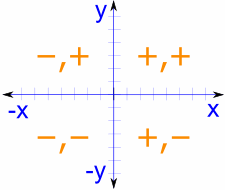In previous posts, wave-like functions were mentioned, and wave-like patterns in the natural world can be represented with trig functions. Sine and cosine, especially, are concepts used heavily in physics for measuring force, work done (force times mass), and special applications for light and sound waves. We have looked mainly at right triangles, but sine and cosine are not limited to this. Here we introduce two more very significant laws. The Law of Sines, and the Law of Cosines.
Let us first consider the Law of Sines:
| Law of Sines Retrieved from http://www.mathwarehouse.com/trigonometry/law-of-sines/images/formula-picture-law-of-sines2.png |
The Law of Sines is a simple ratio, and with a little practice it should become free points on a test. Each angle is opposite its related side, i.e. angle A relates to side a. We need to know any 3 of these elements to find the fourth.
If we have side length a, angle A, and side b for example, we can find angle B. HOWEVER, there is a big catch with this relationship. Notice how a relates to sin(A), b relates to sin(B), and c relates to sin(C). If we have any 3 elements, we might assume we can use the Law of Sines, but say we have length a, Length b, and angle C, we CAN NOT calculate any additional information, because we can only connect two letters like a/A to b/x or c/x.
_____________________________________________________________
Now let us consider the Law of Cosines:
Using the same concept of sides a,b, and c, and angles A, B, and C, we comes up with a formula that is much more complicated, but is much easier to use in practice.
Retrieved from http://mathworld.wolfram.com/LawofCosines.html
Notice this looks like 3 formulas, but it is really only one. What is important to notice is, whatever side we are solving for, we add the OTHER two, then subtract the quantity (2 times the other two, times the cosine of the original). That is too complicated in words, but:
We START with "a" and END with "A". The rest of the formula is b's and c's.
It looks closely related to the Pythagorean Theorum, and that is with good reason. If you are curious about how this formula was derived, visit http://mathworld.wolfram.com/LawofCosines.html. However, that won't be necessary for our course. This formula is brilliant for solving the puzzle of missing sides and angles, and with a basic calculator and a sheet of scratch paper we can discover a great deal of information that is otherwise impossible to find - with absolute precision I might add.
Here is a great video explaining the details if you have the time. Feel free to use it as a resource for your homework, or do a simple Youtube search for the laws:
"When to Use Law of Sines and Cosines"
This has infinite applications, but some historic examples range from finding the distance across a river or calculating the massive distance between planets.
The sky is the limit is certainly an understatement. These laws are deceptively powerful tools for discovery, and are very simple to work with when we have worked through a couple examples!
Sources:
Law of Cosines. (n.d.). Retrieved December 6, 2015, from http://mathworld.wolfram.com/LawofCosines.html



